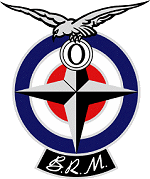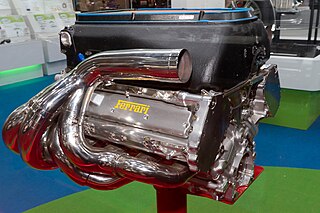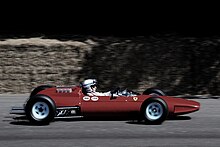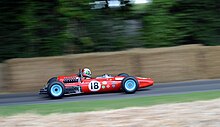
A flat-twelve engine, also known as a horizontally opposed-twelve, is a twelve-cylinder piston engine with six cylinders on each side of a central crankshaft.

Dino was a marque best known for mid-engined, rear-drive sports cars produced by Ferrari from 1957 to 1976. The marque came into existence in late 1956 with a front-engined Formula Two racer powered by a brand new Dino V6 engine. The name Dino was used for some models with engines smaller than 12 cylinders, it was an attempt by the company to offer a relatively low-cost sports car. The Ferrari name remained reserved for its premium V12 and flat-12 models until 1976, when "Dino" was retired in favour of full Ferrari branding.

British Racing Motors (BRM) was a British Formula One motor racing team. Founded in 1945 and based in the market town of Bourne in Lincolnshire, it participated from 1951 to 1977, competing in 197 grands prix and winning seventeen. BRM won the constructors' title in 1962 when its driver Graham Hill became world champion. In 1963, 1964, 1965 and 1971, BRM came second in the constructors' competition.

The Ferrari Lampredi engine was a naturally aspirated all aluminum 60° V12 engine produced between 1950 and 1959. Inline-4 and Inline-6 variants for racing were derived from it.
The Ferrari P was a series of Italian sports prototype racing cars produced by Ferrari during the 1960s and early 1970s.

The Ferrari 312 F1 was the designation of the 3 litre V-12 Formula One cars raced by the Italian team from 1966 to 1969.

The Ferrari 500 was a Formula 2 racing car designed by Aurelio Lampredi and used by Ferrari in 1952 and 1953, when the World Championship was run to F2 regulations.

The 125 F1 was Ferrari's first Formula One car. It shared its engine with the 125 S sports racer which preceded it by a year, but was developed at the same time by Enzo Ferrari, Valerio Colotti and designer, Gioacchino Colombo. Initially the racer was called 125 GPC for Gran Premio Città or Grand Prix Compressore before the Formula One era.

After finding only modest success with the supercharged 125 F1 car in Formula One, Ferrari decided to switch for 1950 to the naturally aspirated 4.5-litre formula for the series. Calling in Aurelio Lampredi to replace Gioacchino Colombo as technical director, Enzo Ferrari directed that the company work in stages to grow and develop an entirely new large-displacement V12 engine for racing.

The Ferrari 156 was a racing car made by Ferrari in 1961 to comply with then-new Formula One regulations that reduced engine displacement from 2.5- to 1.5-litres, similar to the pre-1961 Formula Two class for which Ferrari had developed a mid-engined car also called 156 F2.

The Ferrari 246 F1 is a Ferrari racing car built for the Formula One World Championship of 1958.
This article gives an outline of Formula One engines, also called Formula One power units since the hybrid era starting in 2014. Since its inception in 1947, Formula One has used a variety of engine regulations. Formulae limiting engine capacity had been used in Grand Prix racing on a regular basis since after World War I. The engine formulae are divided according to era.

The Honda RA271 was Honda's first Formula One racing car to enter a race. The chief engineer on the project was Yoshio Nakamura, with Tadashi Kume in charge of engine development. It was driven in three races during 1964 by American driver Ronnie Bucknum.
The Ferrari flat-12 engine family is a series of flat-12 DOHC petrol engines produced by Ferrari from 1964 to 1996. The first racing Ferrari flat-12, the Mauro Forghieri-designed Tipo 207, was introduced in the Ferrari 1512 F1 car in 1964. Later flat-12 racing engines were used in Ferrari Formula One and sports racing cars from 1968 until 1980, including the 212 E Montagna, 312 B series, 312 PB and 312 T series. The roadgoing flat-12 engines were introduced with the 365 GT4 BB and were produced in various versions until the end of F512M production in 1996.

Vittorio Jano designed a new 60° V12 engine for sports car racing for Ferrari. This new engine, introduced in 1956, combined elements of both Colombo and Lampredi engines with new features. Engine architecture was more of Lampredi school but retained smaller Colombo internal measurements. Jano moved to Ferrari along with his designs for the Lancia D50 in 1955 and went on to design not only a new V12 but also a family of the Dino V6 engines soon after. Some of the technical ideas came from the Jano's Lancia V8 DOHC engine, intended for Formula One. This family of engines replaced Lampredi inline-4s known from Ferrari Monza line and went on to win many international races and titles for Ferrari. The design team comprised Jano as well as Vittorio Bellentani, Alberto Massimino, and Andrea Fraschetti.

Ferrari manufactured a series of 3.0-litre, naturally-aspirated, V10 racing engines, exclusively for their Formula One race cars; between 1996 and 2005. They chose a V10 engine configuration, because it offered the best compromise between power and fuel efficiency; the V12 was powerful but thirsty while the V8 was weaker but economical. They switched to 2.4-litre naturally-aspirated V8 engine configuration for 2006. Over its decade-long evolution, power levels varied; from 715 hp @ 15,500 rpm in 1996, to over 900 horsepower, around 935 hp @ 19,000 rpm, toward the end of the 2005 season. The Tipo 05 series of engines, produced between 2001 and 2005, was officially stated to produce between 825 hp @ 17,800 rpm, and 865 hp @ 18,300 rpm. In qualifying mode, however, these engine were reputed to develop up to, or at times over, 900 horsepower (670 kW) at 19,000 rpm.

Ferrari has manufactured three naturally-aspirated V8 racing engines, designed for Formula One racing. First, the Tipo DS50 engine introduced in 1956; with the 2.5 L engine configuration. Second, the Tipo 205/B engine, introduced in 1964; with the 1.5 L engine configuration; and was designed by Franco Rocchi and Angelo Bellei. Then, a 42-year hiatus; until the FIA imposed a 2.4 L engine V8 configuration for all Formula One teams in 2006, with Ferrari introducing their Tipo 056; designed by Gilles Simon.

Ferrari has made a number of V12 racing engines designed for Formula One; made between 1950 and 1995. Some derived engines were also used in various Ferrari sports prototype race cars and production road cars.
Ferrari made four naturally-aspirated V6 racing engines designed for Formula One; between 1958 and 1966. The Formula One regulations for 1954–1960 limited naturally aspirated engines to 2500 cc, and for the 1958 season, there was a change from alcohol fuels to avgas. The 246 F1 used a 2,417.34 cc Dino V6 engine with a 65° angle between the cylinder banks. The power output was 280 PS at 8500 rpm. Bore X Stroke: 85 mm × 71 mm This was the first use of a V6 engine in a Formula One car, but otherwise the 246 F1 was a conventional front-engine design. The Ferrari 246 F1 was good enough to win a World Championship for Mike Hawthorn and a second place in the Constructors' Championship for Ferrari.

















